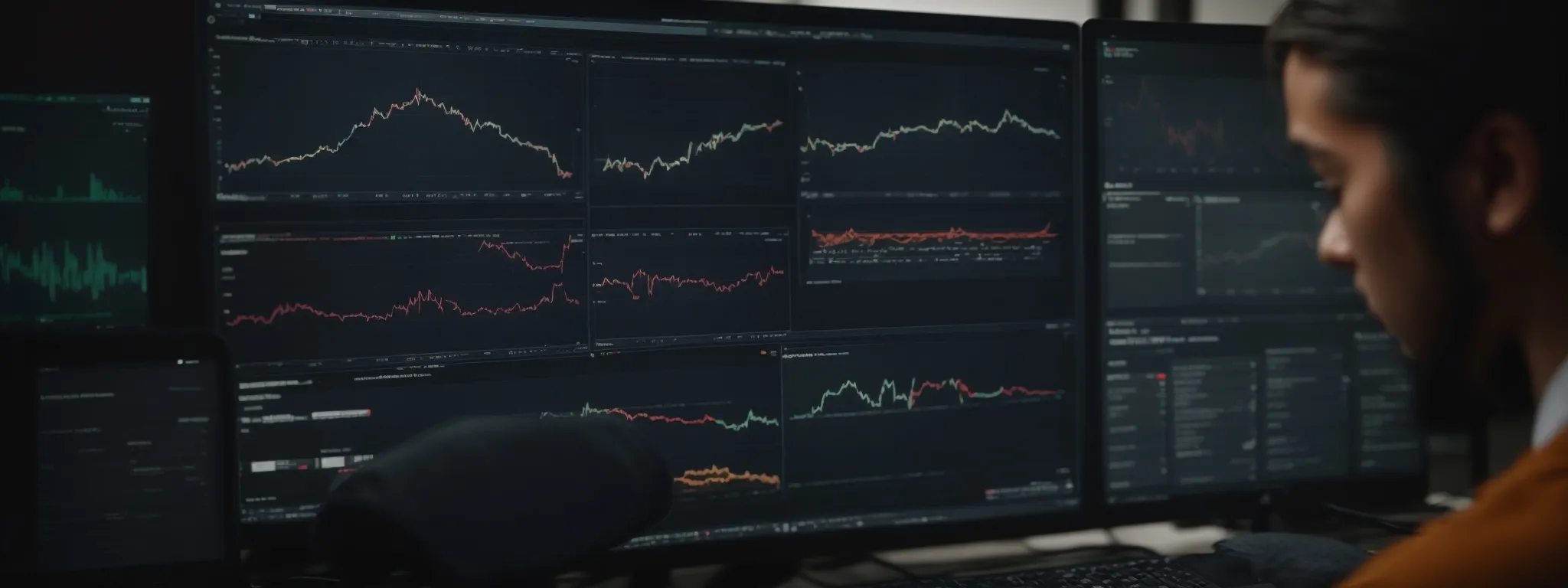Google Indexed Pages—Different SEO Tools
Explore Different SEO Tools for Tracking Google Indexed Pages In the quest to rank prominently on search engine result pages, mastering the art of tracking indexed pages […]
Explore Different SEO Tools for Tracking Google Indexed Pages
In the quest to rank prominently on search engine result pages, mastering the art of tracking indexed pages is non-negotiable.
The intricate dance between Google’s algorithms and a website’s content requires a vigilant eye, ensuring every vital page is scrutinized by Googlebot and nestled securely within the Google index.
SEO tools such as Google Search Console, Ahrefs, and SEMrush rise to the occasion, each offering distinct features for webmasters to stay informed about their site’s index status.
This guide slices through the complexity, comparing these stalwarts of search marketing, highlighting how they enable a robust SEO strategy.
Keep reading as we pull back the curtain on these tools, revealing how they expedite the pursuit of search engine ascension.
Key Takeaways
- Google Search Console Is Essential for Webmasters to Assess Their Website’s Index Status and Improve SEO Strategies
- SearchAtlas by LinkGraph Offers Advanced SEO Tactics That Complement Google Search Console to Enhance a Site’s Search Rankings
- Ahrefs Provides in-Depth Tools Like Site Explorer and a Dashboard for Tracking Indexed Status and Optimizing Backlink Strategies
- SEMrush Enables Comprehensive Tracking and Analysis of a Website’s Index Status and the Effectiveness of SEO Efforts Over Time
- Moz Pro’s Site Crawl and Page Optimization Tools Aid in Addressing Indexing Issues and Enhancing a Page’s Search Rankings
Unveiling the Functions of Google Search Console

Within the realm of Search Engine Optimization, monitoring the presence of web pages in the Google index is paramount for any company striving for online visibility.
Google Search Console (GSC) emerges as a vital tool for webmasters, offering a wealth of functionalities designed to fine-tune a website’s interaction with the search engine.
The ability to set up GSC for indexing checks marks the starting point for webmasters to gain insights into their index page status, which is an integral component of their SEO strategy.
As users delve into the Index Coverage Report, they unravel the complexities behind which web pages are successfully being crawled by Googlebot, along with those hindered by indexing issues.
The URL Inspection Tool further illuminates the path by providing granular details about individual webpages.
Moreover, when GSC is integrated with other advanced SEO tools, it fuels a more comprehensive analysis, propelling search engine rankings to new heights through informed decision-making and refined SEO tactics.
Setting Up Google Search Console for Indexing Checks
Embarking on the journey to optimize a website begins with setting up Google Search Console, a prerequisite for webmasters aiming to keep tabs on their presence within the search google landscape. The process is straightforward, asking users to verify ownership of their website URL, which unlocks the powerful tools and insights GSC provides.
Once verified, webmasters can utilize the platform to submit a sitemap, ensuring Googlebot’s efficient navigation through the site’s structure. This submission acts as a map, guiding the search engine towards a meticulous scan of each document and category page, pivotal to the site’s inclusion in Google index and subsequent search results.
Navigating the Index Coverage Report
An adept webmaster acknowledges the pivotal role of the Index Coverage Report hosted by Google Search Console in providing a microscopic view of a website’s Google index status. Here, individuals are granted transparency over the wide array of web pages, whether indexed or perhaps experiencing obstacles in being discovered by Googlebot.
- The report outlines the number of web pages included in Google’s web index.
- It denotes specific pages that are not indexed and delineates the reasons for their omission.
- Tools within the report equip the webmaster with the means to rectify any indexing issues encountered, facilitating a clear path to improved search engine optimization.
This tool serves as a guide, empowering webmasters to enhance the visibility of their webpages across search results by directly addressing and resolving each identified indexing anomaly. Taking decisive action based on these insights solidifies the SEO strategy, ensuring that each valued document stands a robust chance in the competitive serp landscape.
Understanding the URL Inspection Tool
The URL Inspection Tool in Google Search Console is a beacon for webmasters, shedding light on the intricacies of how individual URLs fare in the vast Google search results. It delivers a detailed diagnosis for a specific website URL, revealing whether the page has been indexed effectively, any crawling errors that may obstruct Googlebot, and offers a snapshot of the page’s visibility in search marketing.
Esteemed users find this tool invaluable as they probe into the minutiae of a webpage’s status, discerning critical factors such as the last crawl date, the detected canonical version, and any structured data errors that may be present. By equipping webmasters with this level of granular data, the URL Inspection Tool proves indispensable, enabling targeted troubleshooting to refine their digital presence.
Integrating GSC With Other SEO Tools for Deeper Analysis
In the current SEO landscape, effectively leveraging SearchAtlas by LinkGraph can transform the way webmasters bolster their search engine rankings. By integrating Google Search Console with SearchAtlas’s array of tools, webmasters can uncover deeper insights and advanced SEO tactics that extend beyond the foundational data provided by GSC alone.
SearchAtlas distinguishes itself by offering unique features for local search optimization and tailored approaches for ecommerce sites aiming to dominate their market. This synergy between the comprehensive data of GSC and the specialized capabilities of SearchAtlas creates an environment where webmasters can conduct a more thorough analysis for their SEO strategy, thus elevating their website’s presence in search result pages.
Harnessing the Power of Ahrefs for Indexed Pages

Among the myriad of SEO tools at a webmaster’s disposal, Ahrefs stands as a sophisticated platform that goes beyond rudimentary tracking of indexed pages.
With its robust Site Explorer feature, Ahrefs offers detailed index tracking that helps to monitor the health of a site’s presence in search results.
By providing comprehensive dashboard analytics and the ability to cross-reference backlink profiles with their indexed status, Ahrefs equips webmasters with the insights necessary to assess and strategize their website’s standing in search engine rankings effectively.
The following sections delve into the diverse capabilities of Ahrefs as an SEO tool that can reveal the depths of a site’s indexation on the web.
Utilizing Ahrefs’ Site Explorer for Index Tracking
In the quest to elevate a site’s SEO footprint, Ahrefs’ Site Explorer emerges as a Powerful Ally for Webmasters. Its index tracking capability enables a detailed examination of a site’s current status in search engine indices, highlighting which pages are garnering visibility and which are yet to be explored by search algorithms.
By harnessing the functionality of Ahrefs’ Site Explorer, SEO professionals can effortlessly pinpoint discrepancies between the pages submitted in an XML sitemap and those that have been successfully added to the Google index. This tool becomes instrumental in identifying the gaps in a site’s indexation, thus providing a clear direction for technical SEO adjustments.
Analyzing Index Health With Ahrefs Dashboard
Ahrefs’ Dashboard affords its users a panoramic view of their website’s health in terms of search engine visibility. The dashboard presents a comprehensive analysis of the indexed pages, highlighting potential discrepancies between the pages that exist on the site and those that the Google search results have acknowledged.
Webmasters can observe trends over time, gauge the effectiveness of their SEO strategies, and align their indexing efforts with the evolving landscape of search engine algorithms. Ahrefs’ Dashboard thus stands as a critical tool for maintaining a pulse on the SEO vitality of a website, helping to ensure that a website’s content is both discoverable and prominent in search engine rankings.
Cross-Referencing Backlink Data With Indexed Status
Ahrefs’ prowess extends to the intricate task of cross-referencing backlink profiles with page index status. This intersection of data sources offers webmasters an unobstructed view into the impact of external links on a page’s search visibility and positioning within the Google web index.
An uptick in quality backlinks may signal to Googlebot the growing relevance of a document, potentially accelerating its inclusion in search result pages. Conversely, identifying pages with numerous backlinks yet absent from the Google index could unearth opportunities to remedy underlying indexing issues:
| URL | Number of Backlinks | Index Status | Actionable Insight |
|---|---|---|---|
| www.example.com/product-page | 150 | Indexed | Monitor for rank improvement |
| www.example.com/category-page | 75 | Not Indexed | Investigate and resolve indexing issues |
The ability to cross-reference these critical SEO elements empowers webmasters to prioritize their link building efforts. They can focus their attention on product pages or category pages that, despite having a wealth of backlinks, may not be reflecting in the search engine results due to indexing challenges.
Using SEMrush to Monitor Indexed Pages Effectively

In today’s competitive digital marketplace, tending to the specifics of a website’s Google indexation is crucial for sustaining and boosting its search engine visibility.
SEMrush, a widely recognized SEO tool, offers a robust suite of features that streamline the process of tracking a website’s index status.
Suitable for both seo novices and seasoned professionals, SEMrush equips users with the ability to construct and manage SEO projects that specifically focus on index tracking, dissect in-depth index page reports, and analyze the progression of indexed pages over time.
This multifaceted approach ensures a comprehensive understanding of a website’s footprint on the web and its growth trajectory in SERPs.
Setting Up SEMrush Projects for Index Tracking
Embarking on the meticulous task of monitoring indexed pages begins with establishing a SEMrush project specifically for index tracking. The platform’s project setup is tailored to accommodate the intricacies of measuring a site’s footprint within the search landscape.
Upon creating a project, SEMrush users are equipped to integrate their website URL, facilitating continuous observation and analysis of a site’s indexed pages over time: ensuring that each strategic move aligns with the site’s performance in search engine rankings.
| SEMrush Project Function | Role in Index Tracking | Benefits to SEO Strategy |
|---|---|---|
| Site Audit | Assesses technical SEO elements impacting indexing | Identifies improvements for search engine accessibility |
| Position Tracking | Monitors SERP rankings for targeted keywords | Provides insights into SEO impact on search visibility |
| Backlink Audit | Evaluates backlink quantity and quality | Guides link building strategy, critical for indexing and ranking |
Exploring SEMrush Index Page Reports
SEMrush’s Index Page Reports present an analytical canvas, mapping out the breadth of a webmaster’s website within the search engine’s cache. These reports are designed to dissect page-by-page indexation, offering insights into which specific pages are embraced by search algorithms and reflect in the search engine results.
Acknowledging the dynamics between web page content and search engine indicators, SEMrush Index Page Reports provide webmasters with a robust tool for assessing the performance of their product page, privacy policy, or any other pivotal component of their site. This enables a focused approach to rectifying any disparities in indexing, crucial for amplifying their visibility in search result pages.
Comparing Indexed Pages Over Time With SEMrush
SEMrush enables users to observe the progression of indexed pages over time, an essential aspect for tracking a website’s growth in the search engine results. This longitudinal analysis sheds light on the efficacy of SEO strategies implemented over a given period, offering valuable insights into their impact on a site’s search engine relevance and authority.
The ability to compare indexed pages across various intervals allows SEO professionals to detect patterns, identify trends, and adjust their approaches proactively. Careful analysis through SEMrush can reveal the momentum of indexing efforts and guide webmasters in fine-tuning their tactics for sustained improvement and dominance in search rankings:
- Assessment of indexed page growth highlights the success of content development and SEO activities.
- Timely identification of indexing drops prompts investigation into potential technical issues or penalties.
- Comparative data provide benchmarks for setting realistic SEO goals and expectations.
Tracking Index Status With Moz Pro Tools

Diligent webmasters understand that tracking a website’s index status is a cornerstone of successful SEO, and Moz Pro offers a suite of tools designed to scrutinize and enhance a site’s visibility in search engine rankings.
Offering a comprehensive approach to technical SEO, Moz Pro begins with its Site Crawl feature to detect indexing problems and provides actionable solutions with its Page Optimization insights.
Furthermore, by merging Moz data with additional tracking utilities, professionals can cultivate a multifaceted view of their website’s performance in search result ecosystems.
Such integrative analysis equips webmasters with the knowledge to refine their online strategies, ensuring each crucial product page and document flourishes in the ever-changing tides of SERP.
Starting With Moz Pro’s Site Crawl Feature
Moz Pro’s Site Crawl feature represents the linchpin in the arsenal of SEO tools for identifying and resolving indexing issues swiftly. It meticulously audits each web page for common errors that could prevent Googlebot from including them in the Google index, offering immediate clarity on any obstacles plaguing a website’s performance in search rankings.
The site crawl process not only uncovers issues but does so with an intuitive interface, providing webmasters with an actionable report detailed with specific errors and the corresponding web pages affected: a streamlined approach for targeted SEO rectification.
| Error Type | Number of Affected Pages | Action Required |
|---|---|---|
| 404 Not Found | 17 | Update URL or Redirect |
| Missing Title Tags | 12 | Add Unique Titles |
| Duplicate Content | 8 | Revise Content or Use Canonical Tags |
Using Moz’s Page Optimization to Enhance Indexability
Moz Pro’s Page Optimization tool stands as a beacon for webmasters seeking to uplift the indexability of their webpages. It scrutinizes every facet of a page, from meta tags to content quality, equipping users with tangible recommendations for boosting a page’s compatibility with Googlebot’s indexing parameters.
This tool extends its utility by Offering Suggestions Tailored to each webpage’s unique SEO needs, ensuring webmasters can craft an optimized version that resonates with search engine requirements. With Moz’s Page Optimization at their disposal, users transform their pages into index-friendly assets poised to climb SERP ranks.
Integrating Moz Data With Other Tracking Tools
Integrating Moz Pro tools with other tracking resources magnifies the comprehensive view available to webmasters who seek to optimize their site’s search engine performance. The amalgamation of Moz’s detailed reporting on indexability with advanced analytics from other platforms unleashes a more dynamic SEO management system, fostering nuanced strategies for improved visibility in the Google index.
Webmasters can blend Moz data on index status with insights from SearchAtlas or Ahrefs to achieve a multi-angled approach to SEO, efficiently leveraging the strengths of each tool. This synthesis of data equips SEO professionals with the capability to respond adeptly to the evolving demands of search engine algorithms and visitor expectations, thus securing a robust digital footprint.
Leveraging Screaming Frog SEO Spider for Indexing Insights

As the digital ecosystem continues to evolve, webmasters and SEO specialists seek robust tools capable of offering insightful data to enhance the indexation of web pages by search engines.
The Screaming Frog SEO Spider emerges as a formidable ally in this quest, renowned for its thorough crawl capabilities that mimic the way search engines like Googlebot explore sites.
This tool not only scrutinizes a website’s architecture but also delivers comprehensive insights, which are crucial for configuring indexation checks.
By integrating Screaming Frog’s granular data with Google Analytics, professionals can paint a detailed picture of their website’s performance and user engagement levels.
Furthermore, the SEO Spider’s exporting functions permit a deep dive into the results, allowing strategists to analyze and adapt to the intricate dynamics of their website’s index status, positioning, and overall search engine visibility.
Configuring Screaming Frog for Indexation Checks
Initiating an indexing check with Screaming Frog SEO Spider begins with configuring the crawl settings to mirror the specific requirements of a website’s architecture and the needs of the SEO investigation. Ensuring Settings like ‘Check Images’, ‘Follow Internal “nofollow”‘, and ‘Crawl All Subdomains’ are adjusted accordingly permits a tailored examination aligned with the site’s structure, maximizing the effectiveness of the audit.
Determining the depth of the crawl is also a crucial step in the configuration, where webmasters have the option to direct the Screaming Frog SEO Spider to crawl the entire website or focus on a subset of pages, such as an ecommerce site’s product pages or a blog post archive. This precision ensures that each URL is meticulously evaluated for its index status, ensuring Webmasters Can Trust the insights gleaned from the crawl results.
Combining Screaming Frog Data With Google Analytics
The confluence of Screaming Frog’s detailed crawl data with Google Analytics equips webmasters with an enriched perspective on user behavior and site performance. By merging these datasets, SEO professionals can discern not only how effectively a page is being indexed but also how visitors interact with it once it appears in the search results.
This integration allows for pinpointing opportunities where a site’s indexation strategy can be aligned more closely with actual user engagement. SEO Strategies Are Consequently Informed by a combination of technical crawl diagnostics and real-world usage statistics, providing a holistic approach to enhancing a site’s online footprint.
Exporting and Analyzing Screaming Frog Results
Upon completing a comprehensive crawl, Screaming Frog SEO Spider facilitates the expedient exportation of results, streamlining the process of analyzing a site’s indexed pages in search engines. These exports, which can be customized to include specific data points relevant to the SEO strategy at hand, serve as a foundation for in-depth examination and subsequent decision-making.
The analytical process begins by dissecting the exported data, typically stationed in convenient spreadsheet formats, to uncover patterns and anomalies. SEO professionals extract actionable insights that directly influence the optimization efforts, Addressing Issues Such as Broken Links, redirect chains, and duplicate content to boost a website’s Google search results prominence:
| Issue Detected | Impact on Indexation | Suggested Action |
|---|---|---|
| Broken External Links | Undermines site authority | Remove or update URLs |
| Overly Long URLs | Could impact crawl efficiency | Shorten and simplify URLs |
| Duplicate Meta Descriptions | Diminishes unique page value | Create distinct meta tags |
Employing Majestic to Audit Indexed Pages

In the landscape of search engine optimization, Majestic emerges as a beacon for professionals committed to elevating their website’s standing in Google’s index.
With its elaborate array of indexing tools, Majestic equips users with the power to audit and enhance their site’s visibility in search engine rankings.
Initiating Site Explorer provides an immediate count of indexed pages, while the Backlink Checker serves as an insightful gauge of a page’s indexation status.
Additionally, Majestic’s capability to trace historical index data offers a strategic advantage, charting the progression of a website’s authority over time.
These tools function in tandem to provide a comprehensive view of a site’s digital footprint, crucial for webmasters intent on refining their SEO prowess.
Initiating Site Explorer in Majestic for Index Counts
Majestic’s Site Explorer stands as a compelling tool for obtaining a precise count of a website’s pages that have found a place in the web index. By inputting a website URL into Site Explorer, webmasters receive an immediate assessment, revealing the volume of pages that have garnered a position within the search engine’s purview.
The utility of Site Explorer in Majestic extends beyond mere numbers, as it offers a deep dive into the links and domains associated with a site’s indexed pages. This level of detail empowers webmasters with a clearer understanding of the factors contributing to each page’s index status, laying the groundwork for nuanced analysis and optimization.
Using Majestic’s Backlink Checker as an Indexation Clue
Majestic’s Backlink Checker serves as a pivotal instrument for SEO professionals seeking to understand a webpage’s indexation status. This tool analyses the arrays of inbound links directed to a specific page, offering insights into the page’s imprints on search engine radars and the impact of link building endeavors on its visibility.
When determining a page’s efficacy in climbing the search engine ranks, Majestic’s Robust Capabilities can reveal a juxtaposition between the quantity of backlinks and a page’s presence in the search engine results. Such data allows webmasters to infer the level of trust search engines may attribute to a page, based on its backlink profile, thus serving as a subtle indicator of indexation status.
Mapping Historical Index Data With Majestic Tools
Majestic’s historical index data mapping offers a chronological perspective that is essential for gauging a website’s progression in SEO. By examining a site’s past indexation footprint, webmasters can identify trends and pivot points that have influenced their current standing in search results.
This capability proves indispensable when strategists need to connect historical link acquisition to fluctuations in page indexation: understanding a site’s past to strategize its future presence effectively across search engines:
| Date Range | Indexed Pages | Backlinks Acquired | Index Impact Detected |
|---|---|---|---|
| Jan-Mar 2022 | 425 | 300 | Minor Increase |
| Apr-Jun 2022 | 450 | 550 | Significant Increase |
| Jul-Sep 2022 | 430 | 200 | Decrease |
The data from Majestic allows SEO experts to scrutinize indexation patterns and informs them on the health and authority of their site over a specific timeline, Fostering Data-Driven Decisions that enhance future SEO campaigns.
Conclusion
In the dynamic field of search engine optimization, the utilization of various SEO tools is integral to effectively track and enhance the indexation of web pages by Google.
Google Search Console serves as the foundational tool, allowing webmasters to monitor index status and troubleshoot issues.
Ahrefs and SEMrush offer in-depth analytics and backlink data that can influence a page’s visibility and search ranking.
Moz Pro bolsters SEO through its Site Crawl and Page Optimization features, focused on identifying and resolving index-related problems.
Screaming Frog provides meticulous crawl capabilities to examine site architecture and its indexing nuances.
Lastly, Majestic aids in auditing the number of indexed pages and analyzing the historical index data, thus contextualizing a site’s SEO journey.
Together, these tools equip SEO professionals with a diverse arsenal to navigate the complexities of indexing, ensuring that websites gain and maintain prominent visibility in search engine rankings.















































































